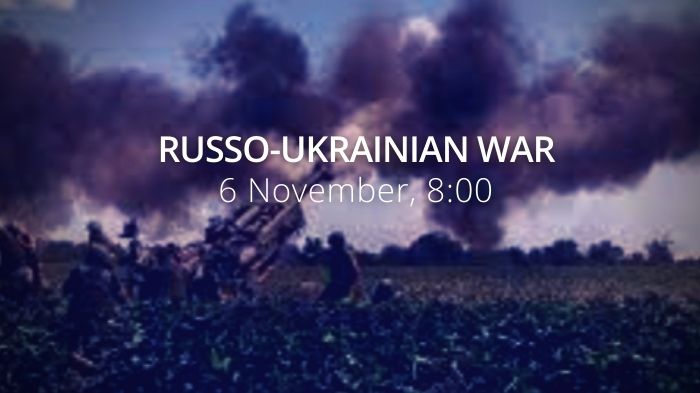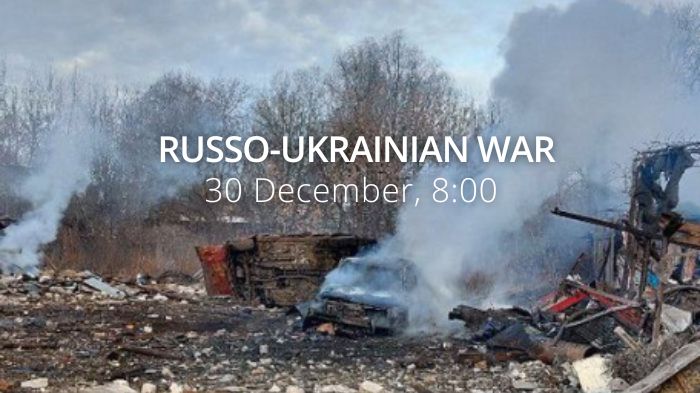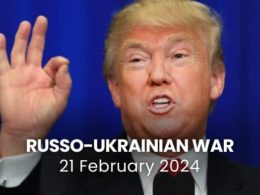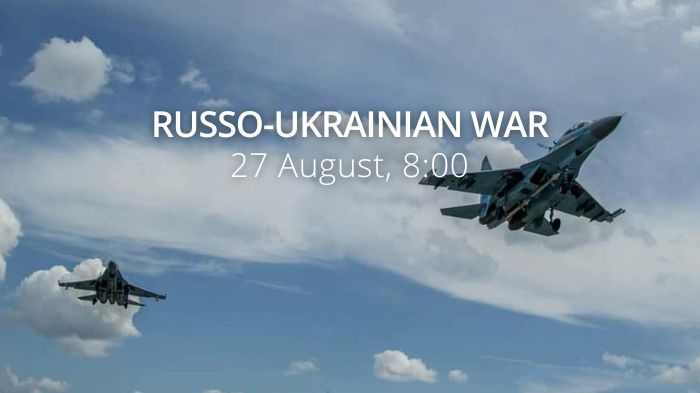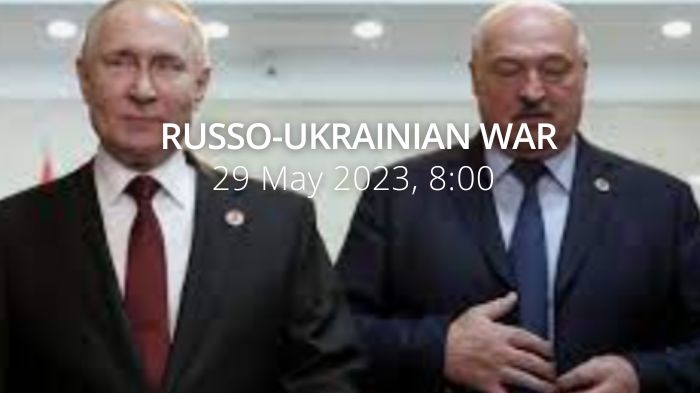Ukrainian troops reportedly continued counteroffensives along the Svatove-Kreminna line. Russian forces continued to set up defensive positions along the Dnipro River. Ukrainian forces continued to target Russian logistics and transportation in Kherson Oblast. Russian forces continued to attack around Bakhmut and claimed unspecified advances. Russian forces continued unsuccessful offensive operations in the Avdiivka-Donetsk City area and in western Donetsk. Iranian Foreign Minister Hossein Amir-Abdollahian confirmed that Iran began providing Russia drones before February 24, denied that Russian forces have used them in combat. Russian forces launch up to ten assault attempts per day in certain areas of the Luhansk region. Ukrainian forces destroy a Russian tugboat near the Antonivsky bridge and damaged two more enemy vessels. Ukraine suffered a comms outage when 1,300 SpaceX satellite units went offline over funding issues. A battalion of Russian conscripts was destroyed in Luhansk Oblast, hundreds were killed. Armed Forces of Ukraine have killed more than 500 Russian prisoners recruited by Wagner private military contractors. Ukraine grid operator steps up rolling blackouts in some regions. External power restored to Ukraine's Zaporizhzhia nuclear plant. The Defense Department says it will support Ukraine for as long as it takes. Dutch military support package for Ukraine. Seventeen EU countries send 500 power generators to Ukraine.
Daily overview — Summary report, November 6
A map of the approximate situation on the ground in Ukraine as of 00:00 UTC 06/11/22.
There have been no notable changes to control since the last update. pic.twitter.com/GpJ5qbvE13
— War Mapper (@War_Mapper) November 6, 2022
The General Staff’s operational update regarding the Russian invasion as of 06.00 am, November 6, 2022 is in the dropdown menu below
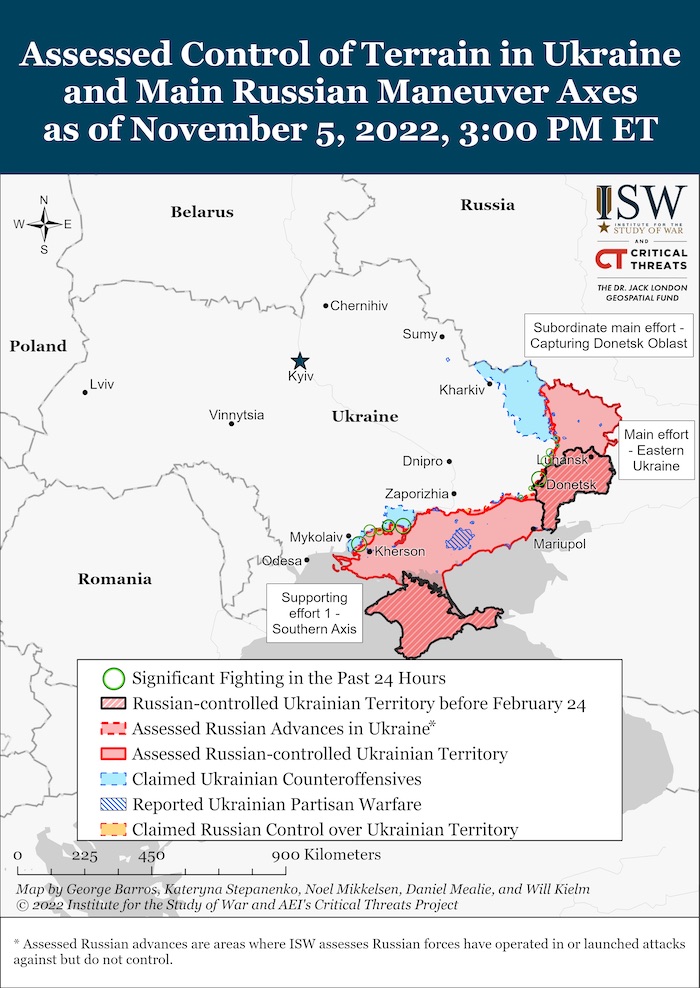
“Russian forces are trying to keep the temporarily captured territories, concentrating efforts on restraining the actions of the Defense Forces in certain areas. Conducts offensive actions in the Bakhmut, Avdiivka and Novopavlivka directions.
Over the past day, units of the Defence Forces of Ukraine repelled enemy attacks in the areas of Zybyne settlements in the Kharkiv oblast, Bilohorivka in the Luhansk oblast; Andriivka, Bakhmutske, Berestove, Mayorsk, Makiivka, Mariinka, Ozaryanivka, Opytne, Pavlivka, Yakovlivka and Yampolivka in Donetsk oblast and Shcherbaky in Zaporizhzhia oblast.
Over the past 24 hours, the Russian occupiers have launched 4 missile strikes, 19 airstrikes and more than 75 MLRS attacks.
Areas of more than 35 settlements in the Chernihiv, Sumy, Kharkiv, Donetsk, Zaporizhzhia, Kherson, and Mykolaiv oblasts were hit by Russian forces.
The situation in the Volyn and Polissya directions has not changed significantly. [According to available information, the combat readiness check of units of the Armed Forces of the Republic of Belarus has been extended until November 14 of this year. There remains the threat of air strikes, including the use of attack UAVs from the territory and airspace of the Republic of Belarus.]
Russian forces shelled in such directions:
- in the Siverskyi direction - from mortars and artillery, in the areas of Mykolaivka and Senkivka settlements in Chernihiv oblast and Studenok in Sumy oblast;
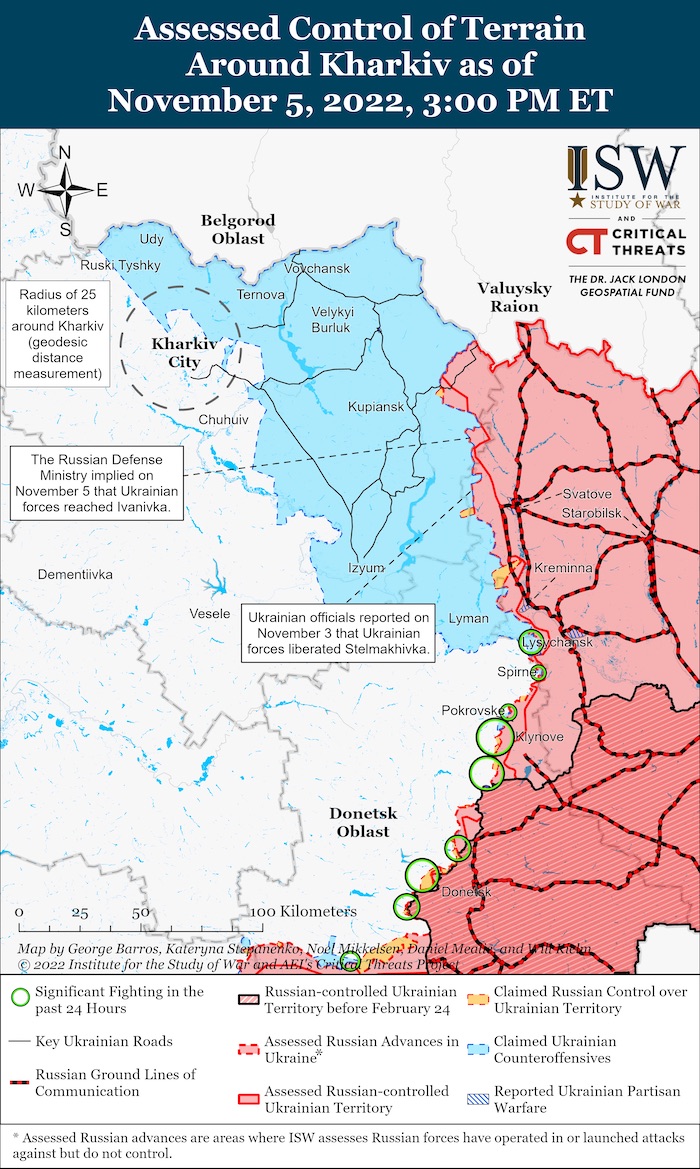
- in the Slobozhansk direction - from mortars and artillery, in the areas of Bolohivka, Budarki, Zybyne, Krasne, Odnorobivka, Okhrimivka, Starytsa, Strilecha and Udy settlements of the Kharkiv region;
- in the Kupiansk and Lymansk directions - from tanks, mortars, artillery and MLRS, in the areas of the settlements of Berestove, Vyshneve, Kotlyarivka in the Kharkiv oblast, Nevske in the Luhansk oblast, and Lyman and Torske in the Donetsk oblast;
- in the Bakhmut direction - from tanks and artillery of various types, in the areas of Andriivka, Bakhmut, Bakhmutske, Bilohorivka, Verkhnyokamianske, Ivanivka, Klishchiivka, Mayorsk, Opytne, Soledar, Spirne and Yakovlivka settlements of the Donetsk oblast;
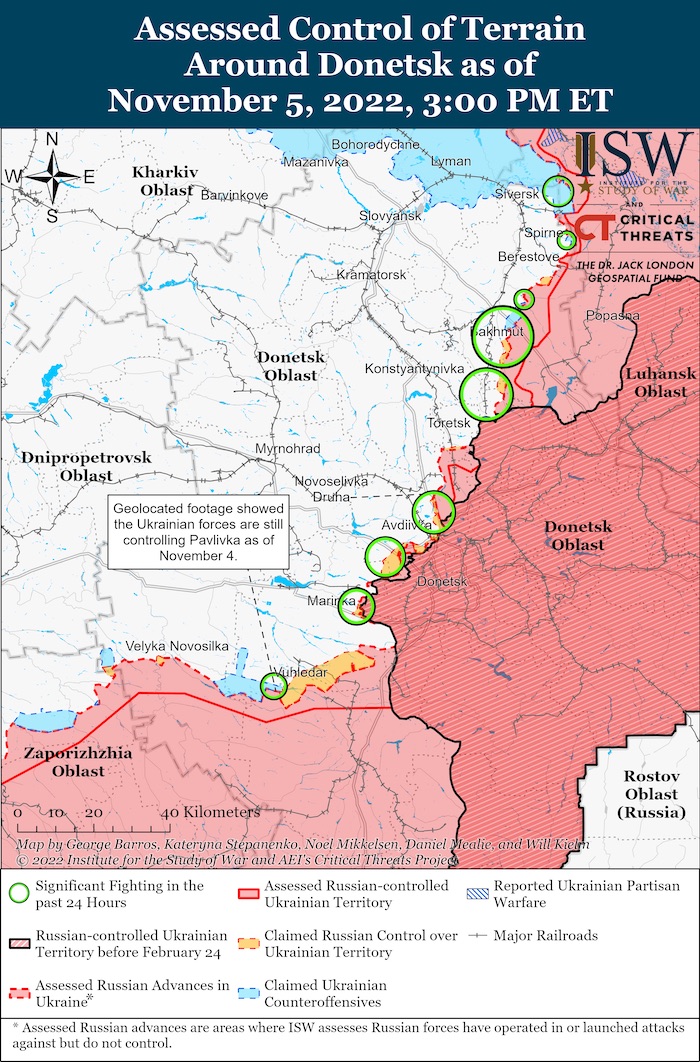
- in the Avdiivka direction - from tanks, mortars, artillery and MLRS, in the areas of Avdiivka, Krasnohorivka, Mariinka, Nevelske, Novomykhailivka, Opytne and Pervomaiske settlements of the Donetsk oblast;
- in the Novopavlivka direction - from the entire variety of artillery, in the areas of the settlements of Bohoyavlenka, Velyka Novosilka, Vodyane, Vuhledar, Vremivka, Pavlivka and Prechystivka in Donetsk oblast;
- in the Zaporizhzhia direction - from tanks, mortars, artillery and MLRS, in the districts of Zaliznychne, Olhivske, Shcherbaky and Yuryivka of the Zaporizhzhia oblast.
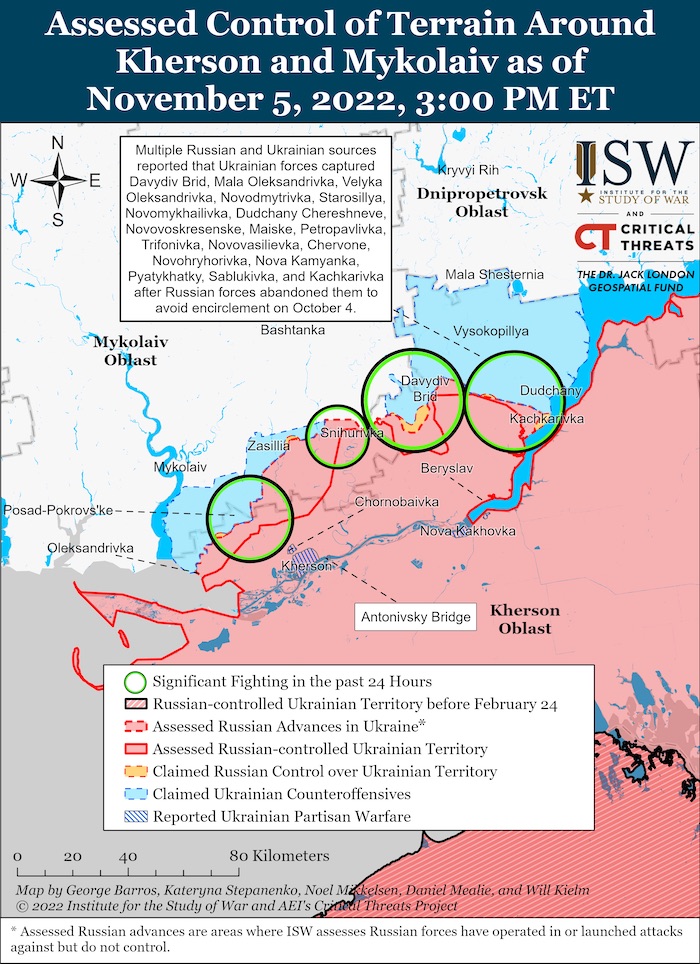
- In the Pivdennyy Buh direction, more than 25 settlements near the contact line were damaged by fire.
Russian occupying forces continue to forcibly evacuate the population from the temporarily occupied territories of the Kherson region. The population of the right bank of the Dnipro River, as well as the 15-kilometre zone of the left bank, is subject to the usual "evacuation". According to available information, local residents are being taken from the settlement of Zavodivka to the temporarily occupied territory of the Republic of Crimea, with further resettlement to the territory of the Russian Federation.
On November 5 of this year, the occupiers sent messages to subscribers of Russian mobile operators in Kherson with a warning about the alleged preparation of massive shelling by the Armed Forces of Ukraine and with an appeal to leave the right-bank part of the city as soon as possible. At the same time, in some settlements, the occupiers destroy the towers of Ukrainian mobile operators.
According to the updated information, the defeat of Russian forces in the previous days in the temporarily occupied territories of the Kherson and Zaporizhzhia regions was confirmed. Thus, in the settlement of Chulanivka, Kherson oblast, an attack was made on the area where the occupiers' unit was concentrated. The headquarters of one of the units of the armed forces of the Russian Federation was hit in the settlement of Basan, Zaporizhzhia oblast, and up to 10 units of military equipment and about fifty servicemen were destroyed. In the areas of Polohy and Marfopil settlements, 20 units of military equipment were destroyed and up to 80 servicemen of the Russian occupation forces were wounded.
[As a result of the actions of the Defense Forces in the Kherson oblast, the area of concentration of the Russian occupation forces in the settlement of Radensk was affected. The losses of Russian forces are specified.]
During the past day, the aviation of the Defence Forces of Ukraine struck Russian forces 7 times. 6 areas of concentration of personnel, weapons and military equipment, as well as the position of Russian anti-aircraft defences, were affected. Ukrainian air defence units shot down 4 UAVs. [According to updated information, 2 Ka-52 "Alligator" helicopters were destroyed the previous day.]
Soldiers of our missile troops and artillery struck in a day Russian command post, 7 areas of concentration of manpower, weapons and military equipment, an ammunition depot and 3 other important military objects of the occupiers.
Military Updates
https://twitter.com/EuromaidanPress/status/1589029542060036096
Russian forces launch up to ten assault attempts per day in certain areas of the Luhansk region, Ukrinform reports, citing the Head of the Luhansk Regional Military Administration, Serhiy Haidai. "In the Luhansk region, the two most difficult sections are the Kreminna and Svatove directions, where the Russians have already managed to bring in freshly mobilized troops. They shell these areas hundreds of times per day, and each day, the Russians try to break through the Ukrainian Army’s defences up to 10 times," the official said.
Haidai added that Sievierodonetsk, where fierce battles were fought this summer, is not being rebuilt. Soldiers are moving into empty apartments, while looting households where expensive property was left behind, loading the loot on trucks and moving it toward Luhansk.”
Ukrainian forces destroy a Russian tugboat near Antonivsky bridge and damaged two more enemy vessels, Ukrinform reports, citing Operational Command South. “Last night, Ukrainian missile and artillery units struck enemy positions, logistics centers, as well as manpower and equipment clusters. They performed more than 70 fire missions.
As a result of another effective fire attack on the alternative river crossing set up by the occupiers along the Antonivsky bridge, a tugboat was destroyed. Two more floating vehicles were damaged and now require repairs, the statement reads.”
Ukraine suffered a comms outage when 1,300 SpaceX satellite units went offline over funding issues, CNN reports. “Ukraine’s fears that its troops may lose access to Elon Musk’s crucial Starlink internet service deepened in the past week after 1,300 of the military’s satellite units went offline, according to two sources familiar with the outage. The small, easy-to-use satellite dishes made by Musk’s private rocket company SpaceX have been universally hailed as a game-changing source of communication for Ukraine’s military, allowing it to fight and stay online even as cellular phone and internet networks have been destroyed in its war with Russia.
But concerns have risen recently over the dependability of SpaceX after discussions about funding were revealed and outages were reported near the frontlines. […] The recent outage started on October 24 and was described by one person briefed on the situation as a “huge problem” for Ukraine’s military.
The terminals had been disconnected, this person said, due to a lack of funding.
The outage affected a block of 1,300 terminals that Ukraine purchased from a British company in March and was used for combat-related operations. SpaceX was charging Ukraine’s military $2,500 a month to keep each of the 1,300 units connected, pushing the total cost to almost $20 million by September, the person briefed on the matter said. Eventually, they could no longer afford to pay, the person said. […] A senior Ukrainian official confirmed the outage, calling the Starlink units “very important” for Ukraine’s fight against Russia.
The September letter from SpaceX to the Pentagon said there were almost 20,000 Starlink terminals in Ukraine. At that time, by SpaceX’s own admission, the majority of them were fully or partially purchased with outside funding, including from the US, Polish and UK governments. The letter claimed those sources paid for about 30% of the monthly connectivity bill as well.
It’s unclear exactly how many terminals Ukraine’s military is operating but the 1,300 that recently shut off represent a significant portion. In July the country’s commander-in-chief wrote Musk directly asking for more, in a letter seen by CNN, saying approximately 4,000 had been deployed by the military. Earlier this month, Musk said that of the more than 25,000 terminals now in Ukraine, fewer than 11,000 were paying for the service, which can run as high as $4,500 per month.
As a result, Musk’s control of the signal gives him significant sway over the battlefield at a time when he has come under heavy criticism for arguing that Ukraine should sue for peace and give up some of its territories.”
Military Updates
According to British Defence Intelligence, (last 48 hours):
- On 03 November 2022, Major General Alexander Linkov was reportedly appointed acting commander of Russia’s Central Military District. Linkov replaces Colonel General Alexander Lapin who was purportedly removed from office at the end of October 2022.
- If confirmed, this follows a series of dismissals of senior Russian military commanders since the onset of the invasion in February 2022. The Commanders of the Eastern, Southern, and Western Military Districts were replaced earlier this year.
- Lapin has been widely criticised for poor performance on the battlefield in Ukraine by both Chechen leader Ramzan Kadyrov and Wagner head Yevgeny Prigozhin. These dismissals represent a pattern of blame against senior Russian military commanders for failures to achieve Russian objectives on the battlefield. This is in part likely an attempt to insulate and deflect blame from Russian senior leadership at home.
- Russia is probably struggling to provide military training for its current mobilisation drive and its annual autumn conscription intake. The Russian Armed Forces were already stretched providing training for the approximate 300,000 troops required for its ‘partial mobilisation’, announced on 21 September 2022. These issues will be compounded by the additional regular autumn annual conscription cycle, announced on 30 September 2022 and starting 01 November 2022, which is usually expected to bring in an additional 120,000 personnel.
- Newly mobilised conscripts likely have minimal training or no training at all. Experienced officers and trainers have been deployed to fight in Ukraine and some have likely been killed in the conflict.
- Russian forces are conducting training in Belarus due to a shortage of training staff, munitions and facilities in Russia. Deploying forces with little or no training provides little additional offensive combat capability.
Losses of the Russian army
As of 6 November, the approximate losses of weapons and military equipment of the Russian Armed Forces from the beginning of the war to the present day:
- Personnel – about 75930 (+490),
- Tanks – 2765 (+7),
- Armoured combat vehicles – 5611 (+10),
- Artillery systems – 1781 (+5),
- Multiple rocket launchers –MLRS - 391 (+0),
- Air defence means – 202 (+0),
- Aircraft - 277 (+0),
- Helicopters - 260 (+0),
- Automotive technology and fuel tanks – 4191 (+7),
- Vessels/boats - 16 (+0),
- UAV operational and tactical level – 1465 (+3),
- Special equipment – 155 (+0),
- Mobile SRBM system – 4 (+0),
- Cruise missiles – 399 (+0)
A battalion of Russian conscripts was destroyed in Luhansk Oblast, hundreds were killed, Ukrainska Pravda reports, citing Verstka, interviewing the surviving Russian soldier and relatives of the conscripts. “A battalion of Russian conscripts from Voronezh Oblast (Russia) was destroyed near the village of Makiyivka, Svatove district, Luhansk Oblast by a Ukrainian strike; hundreds of Russian occupiers were killed. […]
According to Agafonov, the commander of the battalion of conscripts, who were trained in military unit 2079, had promised that the soldiers would be brought to Svatove, where they would join the "territorial defence" 15 kilometres away from the front line. However, on the night of 2 November, the entire battalion was taken to the contact line and ordered to entrench and hold the line of defence.
We were dumped into the forest and ordered to entrench; we had only three shovels for the battalion, and there was no support at all. We entrenched as best we could, and in the morning the [Ukrainian] attack started. [Ukrainian forces used] artillery, Grad MLRS, mortars and copters; we were just shot. When it all started, the officers immediately ran away. In between the attacks, we tried to entrench, but the copters immediately spotted us and just shot us. Out of 570 people, 29 managed to survive, 12 more were wounded, and the rest are all dead.
Agafonov also added that before this incident, at least one other battalion of conscripts was destroyed at the same position.”
Report: Armed Forces of Ukraine have killed more than 500 Russian prisoners recruited by Wagner private military contractors, Ukrainska Pravda reports, citing The Insider. “As of early November, more than 500 Russian prisoners have died in the war in Ukraine. “The publication notes that the Ukrainian Center for the Analytical Studies and Countering Hybrid Threats discovered and verified more than 200 letters signed by Andrey Troshev, one of the heads of the Wagner Group, with condolences to the families of mercenaries recruited by Wagner in Russian colonies.
A posthumous medal "For bravery" is attached to the letters, and the documents themselves, which are often published by relatives on social media, are neatly numbered, which makes it possible to draw conclusions about their number. […] Based on the document numbering, the newspaper concludes that in less than a month (from 18 September to 13 October) Troshev sent at least 224 letters of condolences. In total, at least 458 prisoners hired by Yevgeny Prigozhin died in Ukraine by mid-October.
Over the past three weeks, dozens of new messages from relatives of prisoners about their deaths were published on social media. By the beginning of November, their number definitely exceeded 500. The exact number is unknown since none of the relatives posted photos of the awards where the serial number would be visible (The relatives were probably warned that posting photos of the award documents are prohibited)," The Insider writes.”
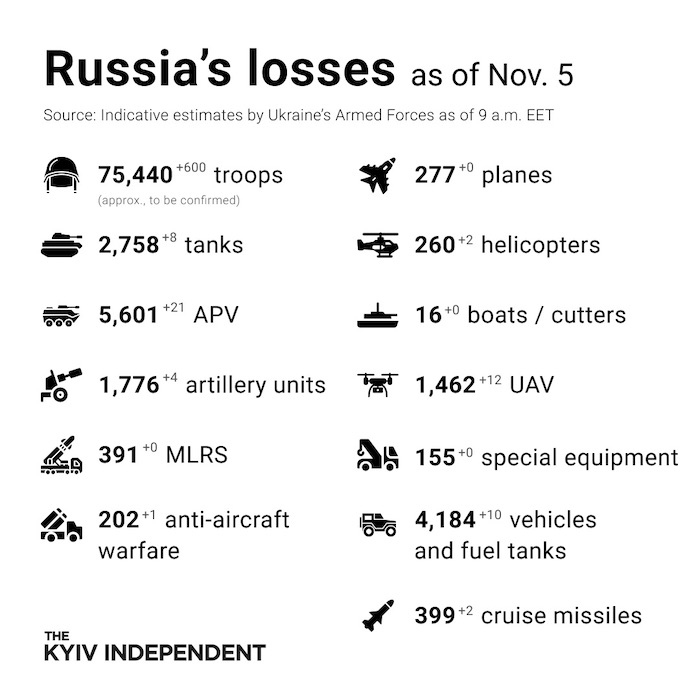
Humanitarian
“I want them to be punished so that their wives feel what I felt then,” the woman says when recalling her painful experience
She was pregnant but 2 Russian soldiers raped her during occupation. She lost her baby. Police identified rapists. Full testimony: https://t.co/wm3wT8oiAN pic.twitter.com/UKFIp2al8M
— Euromaidan Press (@EuromaidanPress) November 5, 2022
Ukraine grid operator steps up rolling blackouts in some regions, Reuters reports. “Ukraine's national grid operator said on Saturday it would step up rolling blackouts in Kyiv and seven Ukrainian regions in response to what it said was increased electricity consumption.
The power grid has been targeted by Russian air strikes in recent weeks and energy providers have resorted to planned power cuts to avoid overloads and to allow infrastructure to be repaired. […] It did not specify how long the blackouts would last but called on Ukrainians to conserve energy, particularly during the morning and evening hours.”
Kyiv Planning for Total Evacuation if It Loses Electricity, The New York Times reports. “The city is also establishing 1,000 heating centers for its 3 million residents, as Russia pounds away at civilian targets. As they struggle to maintain an electricity grid heavily damaged by Russian missiles, officials in the Ukrainian capital, Kyiv, say they have begun planning for a once unthinkable possibility: a complete blackout that would require the evacuation of the city’s approximately three million remaining residents.
The situation is already so dire, with 40 percent of Ukraine’s energy infrastructure damaged or destroyed, that municipal workers are setting up 1,000 heating shelters that can double as bunkers while engineers try to fix bombed-out power stations without the needed equipment.
To try to keep the grid from failing altogether, Ukraine’s national energy utility said on Saturday that it would continue to impose rolling blackouts in seven regions. […] The damage caused by the Russian strikes has heaped new suffering on Ukraine’s civilians and forced officials to reckon with the possibility that further damage could render them unable to provide basic services.
We understand that if Russia continues such attacks, we may lose our entire electricity system, Roman Tkachuk, the director of security for the Kyiv municipal government, said in an interview, speaking of the city.[…] If there’s no power, there will be no water and no sewage, he said. That’s why currently the government and city administration is taking all possible measures to protect our power supply system.”
Environment
https://twitter.com/EuromaidanPress/status/1589064774293364738
External power restored to Ukraine's Zaporizhzhia nuclear plant, IAEA says, Reuters reports. “External power has been restored to Ukraine's Zaporizhzhia nuclear power plant two days after it was disconnected from the power grid after Russian shelling damaged high voltage lines, the UN nuclear watchdog said on Saturday.
Both the plant's external power lines were repaired and reconnection started on Friday afternoon, Rafael Mariano Grossi, director general of the International Atomic Energy Agency (IAEA), said in a
Grossi reiterated his call for the establishment of a nuclear safety and security protection zone around the plant to prevent a nuclear accident, adding: We can't afford to lose any more time. We must act before it is too late."
️Legal
#Ukraine writer, #journalist and #Kherson civic activist Serhiy #Tsyhipa abducted and tortured for #Russia #propaganda video #LetMyPeopleGo #StandWithUkraine #StopRussia #FreeTsyhipahttps://t.co/r2XatEh5bh pic.twitter.com/RDXZbjbPPM
— Halya Coynash (@halyapuff) November 6, 2022
Invaders deport 34 more children from the Kherson region to Russia, Ukrinform reports, citing Yaroslav Yanushevych, the head of the Kherson Regional Military Administration. "The occupiers kidnapped 34 children from the village of Preobrazhenka in the Myrne district. They were moved to the Russian city of Anapa. This was reported by the head of the Myrne settlement military administration, Valentyna Holovata. The parents were promised that their children would be returned by the end of the week, but then the time of stay (allegedly recreation – ed.) was extended again for another week, the governor wrote.
As reported by Ukrinform, the Russian invaders deported 12 pupils of the Oleshky boarding school located in the captured territory of the Kherson region to Russian-occupied Crimea. In total, as of October, since the beginning of the full-scale war, 8,732 Ukrainian children are considered deported to the Russian Federation, and 238 more are considered missing.”
A database of 282 videos exposes the horrors of war in Ukraine, The Washington Post reports. “On Feb. 24, as Russian forces rolled into Ukraine and missiles began to strike Kyiv, civilians picked up their phones and pressed record. For eight months, they have documented the war, allowing the world to witness the conflict in Ukraine through the eyes of its people. New videos emerge each day, taken by local residents, soldiers and public officials. They show the trails of rockets streaming through the sky and the smoldering ruins of towns. Footage has shown slain civilians, some bearing signs of torture, lying in neighborhood streets or unearthed from mass graves.
A growing body of visual evidence has become instrumental for war crimes prosecutors, while also propelling global outrage against Russian President Vladimir Putin’s war. The Washington Post’s visual forensics team has been verifying and cataloguing videos since the start of the invasion.”
430 children were killed, 827 children injured, 10,570 deported by foe forces, and 260 reported missing - the Office of the Prosecutor General of Ukraine reports as of November 6. 2,719 educational establishments are damaged as a result of shelling and bombings, 332 of them are destroyed fully. As of 4 November, 44,389 crimes of aggression and war crimes, and 18,712 crimes against national security were registered.
Support
The Defense Department says it will support Ukraine for as long as it takes, The New York Times reports. “The Pentagon’s resolution to supplying Ukraine with weaponry and the new command are clear signals that the US expects the threat from Russia to Ukraine and its neighbours to persist for years, officials said. The Defense Department is setting up a new command to oversee how the United States and its allies train and equip the Ukrainian military, the Pentagon announced on Friday […].
The Pentagon’s commitment to supplying Ukraine with weaponry and the new command are clear signals that the United States expects the threat from Russia to Ukraine and its neighbours to persist for many years, current and former senior US officials said. The command will ensure we are postured to continue supporting Ukraine over the long term, Sabrina Singh, deputy Pentagon press secretary, told reporters at a news briefing. We remain committed to Ukraine for as long as it takes.
The new command, called the Security Assistance Group-Ukraine, or SAG-U, would streamline a training and assistance system that was created on the fly after the Russian invasion in February. […]. The new command, which will report to Gen. Christopher G. Cavoli, the top American officer in Europe, will carry out the decisions made by the Ukraine Defense Contact Group, a coalition of 40 countries that the Defense Department created after the Russian invasion to address Ukraine’s needs and requests. Senior military officials from the member nations met in Brussels this week.
The changes, which aim to give a formal structure to what has been improvised since the war’s onset, are roughly modelled on US train-and-assist efforts in Iraq and Afghanistan over the past two decades.”
Reznikov on US aid: Each tank will destroy hundreds of invaders, Ukrinform reports. “Ukraine's Minister of Defense, Oleksii Reznikov, has thanked the United States for providing Ukraine with a new package of security assistance worth $400 million. A new $400M US security assistance package is another step towards the victory of good over evil and an investment in a safe 21st century. Each air defence system will save dozens of Ukrainian lives. Each tank will destroy hundreds of invaders, he wrote.
On November 4, the US Department of Defense announced approximately $400 million in additional security assistance for Ukraine under the Ukraine Security Assistance Initiative (USAI). This announcement represents the beginning of a contracting process to provide additional priority capabilities to Ukraine, including funding to refurbish HAWK air defence missiles, 45 refurbished T-72 tanks with advanced optics, communications and armour packages, 1,100 Phoenix Ghost tactical unmanned aerial systems, 40 armoured riverine boats, as well as funding to refurbish 250 M1117 armoured security vehicles.”
Dutch military support package for Ukraine, the Ministry of Defence of the Netherlands says in a press report. “The Netherlands is again supplying heavy military materiel to Ukraine. The total value of the support package is 120 million euros, of which 45 million is designated for the provision of T-72 tanks. Together with the United States and the Czech Republic, the Netherlands will provide 90 modernised and reconditioned Czech tanks. […] The first batch of tanks is expected to be delivered to Ukraine as early as next month.”
Demining occupied part of Luhansk Oblast will take at least 10 years—Obl Head
There are K of airstrikes a day; many shells, mines, rockets are unexploded.
He noted Ukraine asks countries & int orgs for assistance in demining. Now Croatia agreed to help https://t.co/UDefU0j3AF
— Euromaidan Press (@EuromaidanPress) November 5, 2022
Croatia to help demine Luhansk region, Ukrinform reports, citing Serhii Haidai, the head of the Luhansk regional military administration. "️The first thing that is done after the stabilization measures in the de-occupied territories is demining. It will take us years to demine the entire region. First, we will examine the roads and the territory of critical infrastructure. Croatia has agreed to provide assistance in mine clearance, both with specialists and equipment, Haidai said. According to him, this work will take at least ten years.”
Ukraine to raise funds for a fleet of marine drones – Zelenskyy, Ukrainska Pravda reports. "Next week we will launch another fundraising campaign – we will be raising funds for a fleet of marine drones. I think absolutely everyone understands what this is and what it is needed for, and I am sure that millions of people will support this campaign in our defence. Everyone has already seen how it works. And this is only to protect our own maritime area; we do not claim anything that does not belong to us, [President Volodymyr Zelenskyy said in his evening address]."
Seventeen EU countries send 500 power generators to Ukraine, Ukrinform reports. “Ukraine's energy infrastructure has been severely damaged. To sustain access to electricity and heating, 17 EU countries have sent 500 power generators to Ukraine via the EU Civil Protection Mechanism, Directorate-General for European Civil Protection and Humanitarian Aid Operations posted on Twitter.
In particular, Slovenia, Slovakia, Ireland, Austria, Sweden, Spain, Germany, Italy, Denmark, Finland, Estonia, Belgium, Bulgaria, Luxembourg, Cyprus, Poland, and France have provided assistance to the energy sector of Ukraine.
Earlier, Prime Minister of Ukraine Denys Shmyhal stated that Ukraine had already received 700 power generators from foreign partners and another 900 would be delivered in the near future.”
New Developments
In Vienna, Ukrainian posters "Vanguard History of Ukraine" were vandalized the 2nd time in the week
Vandals painted them with red symbols of Russian aggression "Z". The German-language posters had to go to Berlin after Vienna but now will be cleaned first https://t.co/OvbFL5gPSa pic.twitter.com/W6SDTmfIab
— Euromaidan Press (@EuromaidanPress) November 5, 2022
- Abrams, Leopard, Marder, HIMARS: Podoliak names main components of ‘negotiations’ with Russia, Ukrinform “Mykhailo Podoliak, Adviser to the Head of the President's Office, has stated that heavy weapons should be the main components of the "negotiations" of the Ukrainian delegation with Russia. The only possible delegation for ‘negotiations’ with Russia should consist of Abrams, Leopard, Marder, and HIMARS. Meeting place — the easternmost point of the internationally recognized borders of Ukraine, Podoliak posted on Twitter.”
- Russia votes in favour of a resolution condemning its actions in Ukraine, Ukrainska Pravda “Serhii Kyslytsia, Ukraine’s Permanent Representative at the UN, has said that the amendments to the UN’s resolution on combating the glorification of Nazism [Draft Resolution on Combating glorification of Nazism, neo-Nazism and other practices that contribute to fuelling contemporary forms of racism, racial discrimination, xenophobia and related intolerance – ed.] have essentially condemned Russia’s military aggression against Ukraine.”
- The US and Europe seek to assure Ukraine of support, The New York Times “With soaring inflation and energy prices in the United States and Europe stoking concerns in Ukraine that support for the war could wane, the United States and its allies sought this past week to offer Ukraine strong assurances that their military and financial commitment to the war effort would not waver.”
Iran acknowledged for the first time it had supplied Russia with drones allegedly before Feb 24
"Tehran has to realize that consequences of complicity in Russian crimes of aggression against Ukraine will be much larger than benefits," UA MFA rep wrote https://t.co/03gHUXI87P
— Euromaidan Press (@EuromaidanPress) November 5, 2022
- Ukraine’s Ministry of Foreign Affairs reacts to Iran's statements about the supply of drones to Russia, Ukrainska Pravda reports, citing European Pravda. “The Head of the Ministry of Foreign Affairs of the Islamic Republic of Iran has publicly admitted that Tehran has provided drones to Russia, claiming that they were sent to Russia months before the full-scale invasion in Ukraine. The Ministry of Foreign Affairs of Ukraine has stated that Ukraine will continue to take measures to prevent Russia from using Iranian weapons to kill Ukrainians and warned Tehran that the consequences of complicity in Russian aggression will be more extensive than the benefits Iran will receive from its support for Russia.”
- Ukraine Parliament passes wartime budget – Stefanchuk, Ukrinform reports. "The lion’s share of the budget is the issue of defence, it is about providing for the Armed Forces of Ukraine, it is about our future victory. If we gain such a long-awaited victory, I am sure that the budget will be revised. And this will be more about Ukraine's development budget. Questions will be raised about the restoration of Ukraine, fundraising, investments in Ukraine’s economy, issues related to the improvement of social security of Ukrainians, and those related to the reintegration of temporarily occupied territories, so I think that these are articles where budget funds will be redistributed," said the head of the Verkhovna Rada. At the same time, he emphasized that "so far, this is a budget that focuses its lion's share on the issue of our joint victory."
- First traffic observed on North Korea-Russia railway link in several years – media, Ukrinform reports, citing 38North. “A train crossed from North Korea into Russia on Friday afternoon, according to commercial satellite imagery. This is the first traffic observed on the route in several years. It is impossible to determine the purpose of the train from the imagery, but the crossing comes amid reports of arms sales from North Korea to Russia and a general expectation of the resumption of trade between the two countries. While this is the first train observed on satellite imagery travelling between the DPRK and Russia, it does not mean it is the only train that has crossed in recent months.”
Assessment
- On the war.
The Institute for the Study of War has made the following assessment as of 5 November, 2022:
- On the War
The Institute for the Study of War has made the following assessment as of Saturday 5 November:
(quote) “Eastern Ukraine: (Eastern Kharkiv Oblast-Western Luhansk Oblast)
Russian sources claimed that Ukrainian troops continued counteroffensive actions along the Svatove-Kreminna line on November 5. Russian sources, including the Russian Ministry of Defense (MoD), reported that Ukrainian troops conducted an assault in the direction of Kuzemivka, 13km northwest of Svatove. A Russian milblogger claimed that Ukrainian troops crossed the Zherebets River west of Svatove and are probing Russian positions along the Kuzemivka-Kolomyichykha line. Geolocated footage shows Ukrainian troops conducting strikes on Russian armored vehicles about 30km northwest of Svatove, indicating that Russian troops maintain positions in the Yahidne-Orlianka area. A Russian milblogger claimed that Ukrainian forces re regrouping in this area after a failed assault on Yahidne. A Russian milblogger reported that Ukrainian troops continued attempted attacks towards Kreminna. The Ukrainian General Staff reported that Ukrainian troops repelled a Russian attack on Bilohorivka, 10km south of Kreminna. Russian sources also claimed that Ukrainian forces conducted a HIMARS strike on Russian positions in Svatove and Kreminna and shelled Russian positions along the Svatove-Kreminna line.
Southern Ukraine: (Kherson Oblast)
Russian forces continued to set up defensive positions along the Dnipro River on November 5. Spokesperson for the Ukrainian Southern Forces, Nataliya Humenyuk, stated that Russian forces are building strong defensive positions on the left (eastern) bank of the Dnipro River with firing positions that they will use to target Ukrainian forces on the right (western) bank. Humenyuk added that Russian forces are still operating on the right bank. Ukraine’s Southern Operational Command noted that Russian forces are still conducting maneuvers and setting up defensive lines on the right bank, while simultaneously mining the left bank and evacuating civilians at least 15km away from the coast. The Ukrainian Resistance Center specified that Russian forces are preparing Nova Kakhovka (on the left bank) for battle by mining underground communications lines such as sewers. Ukraine’s Southern Operational Command also reiterated that Russian forces are continuing to destroy civilian watercraft and have already destroyed over 50 vessels. ISW has previously assessed that Russian forces are likely attempting to prevent Ukrainian forces from chasing them to the left bank following a fighting withdrawal.
Wagner Group financier Yevgeny Prigozhin seeks to obfuscate his efforts to strengthen his independent power base with an appeal to the concept of Russia’s historic unity. Prigozhin provided a vague response to a media inquiry regarding his recent visit to Kursk Oblast on Russia’s Unity Day (November 4), during which he had indirectly implied that Wagner forces are involved in upholding Russia’s unity. Prigozhin stated that Russian people, businesses, government, and army need to come together to fight for Russia’s sovereignty and its great future while deflecting from the journalist’s question regarding Prigozhin’s reported meeting with Kursk businessmen about the organization of an unspecified people’s militia – outside of formal Russian military command structures. […]
Prigozhin also directly recognized that he is an independent entity, which as ISW previously assessed, relieves him of some obligations to the Kremlin and the Russian Ministry of Defense (MoD). Putin’s dependency on Prigozhin’s forces around Bakhmut also allows Prigozhin privileges such as voicing his criticisms of the Kremlin or the Russian Armed Forces without significant ramifications. Prigozhin has also coincidentally opened his Wagner Center in St. Petersburg on Russia’s Unity Day. However, Prigozhin is notably shielding his efforts to build an independent power base and shape the conduct of Russia’s invasion of Ukraine with language focused on Russian Unity – likely both to appeal to Russian nationalists and civilians and to deflect criticism of his fairly overt efforts to build an independent power base.
Prigozhin continues to rely on ineffective convicts to staff his forces. Prigozhin declined to comment on a reporter’s question regarding ongoing recruitment drives at Krasnoyarsk Krai penal colonies, despite previously openly discussing prisoner participation in the war with Russian outlets like RiaFan. Russian opposition outlet The Insider, however, found that over 500 prisoners recruited into Wagner units have died in the past two months. The publication added that Wagner lost between 800 and 1,000 mercenaries in Ukraine, indicating convicts comprise a large proportion of Wagner’s forces in Ukraine. Ukrainian intelligence officials also previously reported that many prisoners suffering from infectious diseases infected Wagner troops, to which Prigozhin responded that he does not discriminate on the basis of illness.
Iranian Foreign Minister Hossein Amir-Abdollahian confirmed that Iran sent Russia combat drones. Amir-Abdollahian stated on November 5 that Iran “gave a limited number of drones to Russia months before” the war in Ukraine. Amir-Abdollahian also claimed that if Ukrainian officials could prove that the Russian military has used Iranian-made drones in Ukraine then Iranian officials would “not be indifferent” to the concern - falsely and ridiculously implying that Russia has not used the drones that he admitted Iran has provided. Iran’s confirmation of the drone shipments further supports ISW’s previous assessments that Russia is sourcing Iranian-made weapons systems to address the depletion of its high-precision munitions arsenal. ISW previously assessed that Iran is likely already exploiting Russian reliance on these Iranian-made weapons systems to request Russian assistance with its nuclear program. The nuclear assistance requests and the recognition of the drone shipments are both indicators that Iranian officials may intend to more clearly establish an explicit bilateral security relationship with Russia in which they are more equal partners.
Former Donetsk People’s Republic (DNR) Security Minister and current DNR military commander Aleksandr Khodakovsky claimed on November 5 that Russian friendly fire may have caused up to 60% of total Russian losses since the end of Russian offensive operations in Mariupol in mid-May. Even if this statistic is exaggerated, the fact that a Russian commander is publicly speculating on such a damning indicator of Russian and proxy competency indicates the deep challenges Russian forces face. Friendly fire typically does account for a limited number of losses in war but ordinarily nowhere near 60% of total casualties, which demonstrates a lack of communication and command and control coordination between Russian forces. Russian and Ukrainian sources also reported that a Russian rotation returning to its base near Pavlivka, Donetsk Oblast on November 5 drove into a ditch constructed by army subcontractors without prior discussion or warning, further demonstrating a widespread lack of cross-training and coordination between Russian troops. The frequent replacement of Russian military leaders, promotion of inexperienced soldiers, and cobbled-together Russian force composition including Russian contract soldiers, Russian mobilized soldiers, DNR and Luhansk People’s Republic (LNR) forces, and Wagner Group forces exacerbate the fragmented nature of the Russian chain of command and ineffectiveness of Russian forces and likely contributes to frequent friendly fire incidents.
Key Takeaways
- Wagner Group financier Yevheniy Prigozhin seeks to obfuscate his efforts to strengthen his independent power base with an appeal to the concept of Russia’s historic unity.
- Iranian Foreign Minister Hossein Amir-Abdollahian confirmed that Iran began providing Russia drones before February 24, but strangely denied that Russian forces have used them in combat.
- DNR military commander Aleksandr Khodakovsky claimed that Russian friendly fire may have caused up to 60% of total Russian losses since mid-May.
- Ukrainian troops reportedly continued counteroffensives along the Svatove-Kreminna line.
- Russian forces continued to set up defensive positions along the Dnipro River.
- Ukrainian forces continued to target Russian logistics and transportation in Kherson Oblast.
- Russian forces continued to attack around Bakhmut and claimed unspecified advances.
- Russian forces continued unsuccessful offensive operations in the Avdiivka-Donetsk City area and in western Donetsk.
- Continued poor conditions for mobilized soldiers catalyzed a large-scale protest in Kazan.
Russian forces continued forced evacuations in Kherson Oblast. Over 80% of Kherson residents reportedly have evacuated.
Assessment of the situation and expectations for the upcoming months by Michael Kofman, the director of Russia studies at C.N.A., a defense research institute based in Virginia. “A few thoughts on the current course of the war, and some impressions after a recent visit to Ukraine with several colleagues from the mil analysis community, including areas near the front in Kherson. The general sense one gets is that Ukraine is winning the war and morale is high, but like any military operation, you see friction up close that you can’t from a distance. A fair bit of the Ukrainian effort is ground up, based on horizontal linkages, volunteers, apps, etc.
Russia’s military appears at its most vulnerable going into the winter, but Ukraine has seen some modest impact from Russian mobilization. Troops are being deployed to try and stabilize Russian lines, and increase force density relative to terrain.
The situation in Kherson is clear as mud. Russian forces seemed to withdraw from some parts, evacuated, and drew down, but also reinforced with mobilized personnel. The fighting there is difficult. Despite constrained supply, Russian forces do not appear to be out of ammo. I think this is a fog of war issue right now, with contradictory indicators, but to me, the preponderance of evidence points to a Russian decision to steadily retreat from the right river bank and avoid being cut off there, while also trying to exact a high cost.
Ukrainians I spoke to seemed optimistic they can press Russia out of Kherson (west of the river) by the end of the year. There are outstanding questions about the Khakovka dam, and whether Russia might sabotage it upon withdrawal. This issue is more salient than the talk of RDDs. Still, it remains unclear whether Russia intends to fight for Kherson city, perhaps using more expendable or mobilized units while preserving better troops. I'm sceptical Russia will abandon all positions on that side without being forcibly pressed out but could be wrong on this.
Forcing a Russian retreat from Kherson’s right bank will bring UA systems within range of some ground lines of communication from Crimea. But, it will also give Russian forces a large natural barrier, less terrain to defend, and a higher force density to terrain ratio.
Overall, it seems unlikely that the war will die down over the winter, even if some months make offensive operations challenging. Ukraine will likely leverage its advantage in range and precision to attrit the Russian military over this period.
Strikes across Ukraine are leading to blackouts and electricity conservation. Ukraine is resolving these blackouts quickly, and if anything the bombardment campaign bolsters resolve, but over time the challenges from these strikes could mount, straining equipment and ADS ammo.
I’ve been dismissive of the Belarus vector, despite recent Russian deployments there. But the situation merits tracking over the coming months if the numbers of Russian troops grow and they are provided with heavy equipment.
Mobilization and its potential downstream effect 3-4 months from now introduces a degree of uncertainty. It could extend the war, or make future Ukrainian offensives more costly, but I think Ukraine is preparing for a range of possibilities depending on what mobilization yields.
On mobilization, I largely hold to the thoughts in this earlier thread. It seems Russia is taking a staggered approach, throwing some mobilized personnel with little training to stabilize lines, but holding many back to reconstitute units or form reserves. However, the Russian Armed Forces could use mobilized personnel first to raise manning levels in currently deployed BTGs, many of which seem at 40-50%. The morale of mobilized personnel might be low, but individual replacements can start filling these units out faster than establishing new units.
Russian strategy appears to be focused on defence over the winter, hoping that mobilization can rebuild their forces. If the pressure lets up they will use the time to get more equipment out of storage (including from Belarus) and potentially ammo from sources like DPRK.
In the east Russian forces appear desperate to hold the Troitske-Svatove-Kreminna line and are trying to dig in for the winter. Here a Ukrainian breakout could prove significant. In general it seems Russia approach is to try and fix a defensible line and hope to maintain over the winter. Ukrainian objectives are likely to prevent Russian force reconstitution over the winter, generate additional forces in the interim (which requires more equipment), and acquire air defences to reduce the threat from the Russian strike campaign against critical infrastructure.”
Ukrainian forces brace for bloody fight for Kherson, Reuters reports. “Oleh, the commander of a Ukrainian mechanized infantry unit dug into trenches west of Kherson, is confident his Russian foes will be forced to abandon the strategic port by winter weather, logistical logjams and the threat of encirclement. But neither he nor his men think the Russians will go quickly or quietly and nor do they intend to let them. His comments raise the spectre of a bloody slog in the coming weeks for control of a key city on the west bank of the Dnipro River which acts as a gateway to the peninsula of Crimea annexed by Russia in 2014.
They will keep fighting. They will defend their positions as long as they have the ability to do so," said Oleh, 26, a battle-hardened major who has risen through the ranks since enlisting as a teenager 10 years ago. "It will be a hard fight. […]
The contest for the only provincial capital seized by Moscow in the full-scale invasion launched on Feb. 24 may be one of the most consequential of the war so far. For Russian President Vladimir Putin, it would be another setback following a series of significant battlefield losses since mid-August.
With control of the Dnipro's west bank, military experts said, Ukrainian forces would have a springboard from which to seize a bridgehead on the east side for an advance on Crimea. […] Were Kherson to fall in the counter-offensive, the experts added, it would also be a political humiliation for Putin, as Kherson is one of four partially occupied regions of Ukraine that he announced would be part of Russia "forever" with great fanfare on Sept. 30.
It would be a massive blow, primarily politically, said Philip Ingram, a retired senior British military intelligence officer. And it would cost him (Putin) militarily. If the Ukrainians were able to get a bridgehead on the east side of the Dnipro, that would be even worse for the Russians.
The Ukrainians will be able to hammer the Russians defending the approaches to Crimea, said retired US General Ben Hodges, a former commander of US Army forces in Europe. A US official, speaking on condition of anonymity, said it appeared the Russians already had begun an organized, phased withdrawal from the Dnipro's west bank. […]
The US official and Ukrainian commanders said the Russians had been reinforcing their front lines, including deploying recently mobilized reservists, in a bid to better protect the withdrawal. Some Ukrainian soldiers believe the poorly trained Russian reservists are being sent forward "like lambs to the slaughter", while more experienced troops are digging into defensive lines further back, according to the US official.
An orderly pullout could prove challenging for the Russians, requiring coordination, deception to conceal movements, communications discipline, and intense artillery barrages to suppress Ukrainian advances.
But Ukrainian troops could also face serious obstacles that could stall their takeover of Kherson, including booby traps and concentrated Russian artillery and rocket fire from the east bank, Hodges said. […]
If we don't start an attack, they will just keep sitting there, Oleh said. The mobilized ones are good for us because they generate panic. Panic is infectious like a disease. It spreads."
Russians seek to lure Ukraine forces into urban battles, Ukrinform reports, citing Natalia Humeniuk, head of the Joint Coordination Press Center of the Southern Defense Forces. “Answering a question about the probability of traps set up for the Ukrainian military during the counteroffensive, Humeniuk noted: "Such a situation is not excluded, as they are very deliberately trying to convince us that they are withdrawing. That's despite the fact that we see objective data that they remain in place. There are defence units that have dug in there quite powerfully, a certain amount of equipment has been left, firing positions have been set up, and, in particular, the firing positions that are being set up on the left bank will be used to support those on the right bank."
According to the spokeswoman, the invaders are trying to create an effect as if they are not there, in order to lure Ukraine's forces into certain settlements. And any settlement is always about complex urban battles. Therefore, we know, see and foresee the developments that they are trying to impose on us, and we are drawing up our strategic plan, Humeniuk emphasized.
She noted that the situation in the Kherson region is developing according to a scenario that is incomprehensible even to the occupiers themselves, as they are trying to create the impression of multifaceted developments: they are both entrenching themselves and evacuating. At the same time, according to her, the invaders pass along the piers and moorings, destroying any watercraft they come across.”
- Consequences and what to do?
Iran is likely already exploiting Russian reliance on Iranian-made weapons systems to request Russian assistance with its nuclear program, The Institute for the Study of War reports. “CNN reported on November 4 that unspecified US intelligence officials believe that Iranian officials have been asking Russia for help in acquiring additional nuclear materials and with nuclear fuel fabrication. Nuclear fuel could allow Iran to shorten the breakout period to create a nuclear weapon depending on the kind of fuel and the kind of reactor for which it is being requested. CNN reported that it was unclear whether Russian officials had agreed to Iranian requests. ISW has previously reported that Iranian plans to send more combat drones and possibly ballistic missile systems to Russia will likely strengthen Russia’s growing reliance on Iranian-made weapons systems.
Ukrainian Main Military Intelligence Directorate (GUR) representative Andriy Yusov stated on November 4 that GUR has not received information confirming that Iranian missile systems have arrived in Russia despite intelligence that confirms the contract for the transfer of those systems. Yusov also stated that another shipment of 200 Iranian-made combat drones to Russia is currently underway. Ukrainian Minister of Defense Oleksii Reznikov reported on November 4 that Russian forces have almost completely used up the first set of 300 combat drones from Iran. Reznikov reported that Russia currently has contracts to receive 1,500 to 2,400 more Iranian-made combat drones, assuming Iran can fill the orders. Russia’s growing reliance on these systems allows Iran to exert greater influence on Russian officials, and Iranian officials have already likely started to exploit that influence in support of its nuclear program. The Iranian requests for Russian assistance with its nuclear program may be an indicator of an intensifying Russian Iranian security partnership in which Iran and Russia are more equal partners.”
US privately asks Ukraine to show it’s open to negotiate with Russia, The Washington Post reports. “The Biden administration is privately encouraging Ukraine’s leaders to signal an openness to negotiate with Russia and drop their public refusal to engage in peace talks unless President Vladimir Putin is removed from power, according to people familiar with the discussions. The request by American officials is not aimed at pushing Ukraine to the negotiating table, these people said. Rather, they called it a calculated attempt to ensure the government in Kyiv maintains the support of other nations facing constituencies wary of fueling a war for many years to come.
The discussions illustrate how complex the Biden administration’s position on Ukraine has become, as US officials publicly vow to support Kyiv with massive sums of aid “for as long as it takes” while hoping for a resolution to the conflict that over the past eight months has taken a punishing toll on the world economy and triggered fears of nuclear war.
While US officials share their Ukrainian counterparts’ assessment that Putin, for now, isn’t serious about negotiations, they acknowledge that President Volodymyr Zelensky’s ban on talks with him has generated concern in parts of Europe, Africa and Latin America, where the war’s disruptive effects on the availability and cost of food and fuel are felt most sharply.
Ukraine fatigue is a real thing for some of our partners, said one US official who, like others interviewed for this report, spoke on the condition of anonymity to discuss sensitive conversations between Washington and Kyiv. […] In the United States, polls show eroding support among Republicans for continuing to finance Ukraine’s military at current levels, suggesting the White House may face resistance following Tuesday’s midterm elections as it seeks to continue a security assistance program that has delivered Ukraine the largest such annual sum since the end of the Cold War.
In a trip to Kyiv on Friday, White House national security adviser Jake Sullivan said the United States supported a just and lasting peace for Ukraine and said US support would continue regardless of domestic politics. We fully intend to ensure that the resources are there as necessary and that we’ll get votes from both sides of the aisle to make that happen, he said during a briefing. […]
Russia, facing a poor position on the battlefield, has proposed negotiations but in the past has proved unwilling to accept much other than Ukrainian capitulation. Cynically, Russia and its Western supporters are holding out an olive branch. Please do not be fooled: An aggressor cannot be a peacemaker, Andriy Yermak, head of the Ukrainian presidential administration, wrote in a recent op-ed published by The Washington Post.
Ukrainian officials also question how they can conduct negotiations with Russian leaders who fundamentally believe in Moscow’s right to hegemony over Kyiv. Putin has continued to undermine the notion of a sovereign and independent Ukraine, including in remarks last month when he once again asserted that Russians and Ukrainians were one people, and argued that Russia could be the only real and serious guarantor of Ukraine’s statehood, sovereignty and territorial integrity. […]
The maximalist remarks on both sides have increased global fears of a years-long conflict spanning the life of Russia’s 70-year-old leader, whose grip on power has only tightened in recent years. Already the war has deepened global economic woes, helping to send energy prices soaring for European consumers and causing a surge in commodity prices that worsened hunger in nations including Somalia, Yemen and Afghanistan.
In the United States, rising inflation partially linked to the war has stiffened head winds for President Biden and his party ahead of the Nov. 8 midterms and raised new questions about the future of US security assistance, which has amounted to $18.2 billion since the war began. According to a poll published Nov. 3 by the Wall Street Journal, 48 percent of Republicans said the United States was doing “too much” to support Ukraine, up from 6 percent in March.
Progressives within the Democratic Party are calling for diplomacy to avoid a protracted war, releasing but later retracting a letter calling on Biden to redouble efforts to seek “a realistic framework” for a halt to the fighting.
Speaking in Kyiv, Sullivan said the war could end easily. “Russia chose to start it,” he said. Russia could choose to end it by ceasing its attack on Ukraine, ceasing its occupation of Ukraine, and that’s precisely what it should do from our perspective.”
Hans Petter Midttun: Today’s assessment will be published as a separate article. A teaser:
“According to Ukraine, the war started on 20 February 2014. The date is engraved in the Russian medal “For the return of Crimea”. Still, international media and politicians alike insist that the war started 8 years later 24 February 2022.
If we struggle to acknowledge the start of an ongoing hybrid war, how will we be able to recognise the start of a nuclear war? Does it start when the first nuclear weapon is detonated on the battlefield, or did it start years before? Are we once again failing to acknowledge an unpleasant reality?
I would argue that if nuclear arms are an integrated part of the hybrid war and conceding to the fact that Russia has been waging a hybrid war against Europe and the US for years, we must also acknowledge that we are also de facto exposed to a nuclear war.
Like the Hybrid War, a nuclear war does not start with a crisis (or the nuclear detonation over the potential target). It follows the same five phases as the hybrid war: 1. Shaping, 2. Active, 3. Crisis, 4. The resolution, and 5. Restoration of peace.
We are presently in the third phase. We have already experienced multiple cases of Russian ultimatums, threats and attempts of nuclear blackmail. It is conducting conventional warfighting around Ukraine’s 15 Nuclear Power Plants and its control of the Zaporizhzhia Nuclear Power Plant has long been deemed outright unsafe and in breach of its international commitments.
The international community is already facing a hybrid war and, consequently, the very real risk of widespread nuclear contamination. While I have repeatedly argued why I don’t buy into the Russian nuclear blackmail, the fallout of an unintended nuclear accident is equally damaging for our collective health and security as a direct nuclear war.
The risk of nuclear proliferation to Iran and North Korea adds concern to an already “ongoing nuclear war”.
The only way to alleviate our concerns is ironically to call the bluff.”

